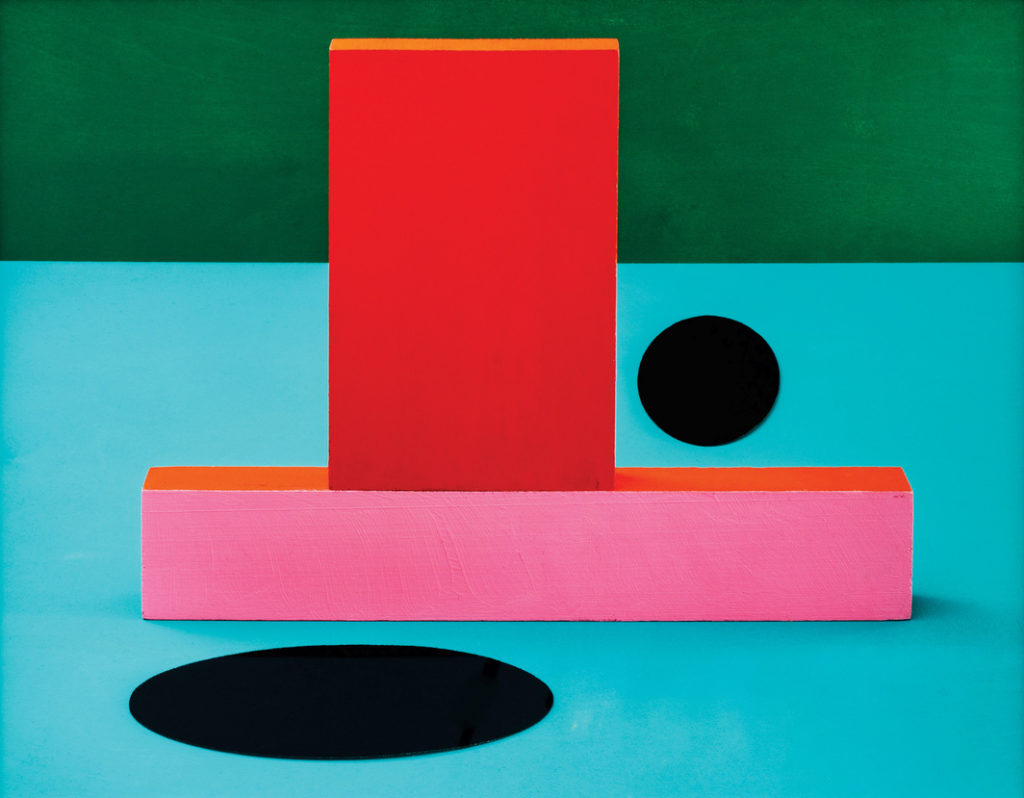Erin O’Keefe at Seventeen
by Emily LaBarge

The wrongness of images, or our apperceptions of them: What appears to be a painting is actually a photograph. What appear to be two-dimensional painted lines, curves, rectangles, arabesques, planes of color, or abstract geometries with trompe l’oeil shadows are in fact three-dimensional objects carefully arranged, brightly illuminated, and flattened into a beguiling single plane by the lens of a camera. “I’m interested in finding/discovering/choreographing moments of uncertainty that exist in the image, but not in the ‘real’ spatial condition,” says Erin O’Keefe, erstwhile architecture professor turned full-time photographer of vision-confounding images. “You are left with just the image and its wrongness—you can never backtrack to compare, although the question of how it was made is still present.”
In Cleavage (all works 2020), a white curlicue, a sort of mutated comma, stands against grounds of muted dove-blue shades, its curved forward edge painted a rich opalescent red, like Cupid’s-bow lips. Next to it—or behind? abutting? adjacent?—the vivid-orange edge of another shape, this one bulbous and chalky blue, mirrors the red curve in inverse: Convex crimson meets concave tangerine. The thick lines ebb and flow, emerge and recede. The eye recognizes but cannot entirely unravel distortion; the mind flits between different possibilities. However, as with Wittgenstein’s duck-rabbit, Escher’s irrational cube, or Penrose’s tribar, no settled reality emerges. Is the swath of turquoise blue in Circle, Circle flat or angled? How does one black circle face us directly, while the other lies flat and foreshortened, like Holbein’s famous disk-shaped skull? In River, does the undulating pine-green wedge with its rough, mint-painted upper edge balance perilously on the slender sky-blue rectangular prism, or does it lie flat against the rose-pink ground perpendicular to a fire-orange backdrop? Does it matter? Why do I want to know?
O’Keefe’s photographs—of various sizes, though in this show always larger than the objects they depict—subtly, even cheerfully, disrupt the eye’s or the camera’s ability to comprehend space. The artist’s work recalls her background in architecture, a discipline in which model building—the construction of synthetic trials and variants of space in miniature as a means of testing possibilities—is essential. O’Keefe produces images that are also intensely painterly, with a sensitive understanding of the spatial play, perspective, color, and incongruity in the works of artists as varied as Josef Albers, Giorgio de Chirico, Le Corbusier, Fernand Léger, Henri Matisse, and Giorgio Morandi. Or, to go even farther back, the radiant flatness and luminous shades of Fra Angelico, Giotto, Masaccio, Paolo Uccello.
Nothing in O’Keefe’s first London exhibition, “Certain Things,” was certain. But the New York–based artist’s works are more than canny analog reminders of the digitally manipulated images and technological unrealities that surround us, of our need to remember that we do not always know what we are looking at. Her photographs assert the positive value of uncertainty and not knowing and induce the pure retinal pleasure of trying to unriddle a collision of colors and planes that shift and slide, refusing to stay fixed. They are the product of a practice in which repetition—not to mention time, effort, patience, and absorption—produces unexpected combinations.
“Art is a true account of the activity of the mind,” writes Donald Barthelme in his 1982 essay “Not-Knowing.” In O’Keefe’s tiny, jewel-colored constructions photographed large, the space of the studio—iterations of space within this space—transcends itself for a moment only. These are records of an artist thinking in two and three dimensions at once.
